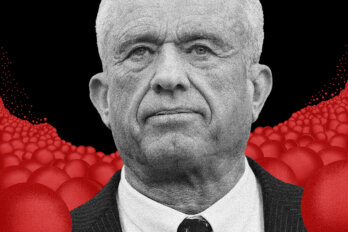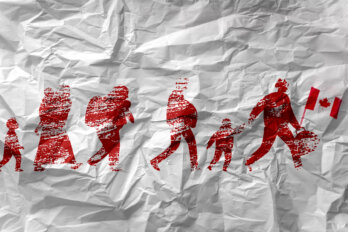In a video posted by a popular TikTok account called @TorontoTide, which conducts man-on-the-street interviews around the city, a young man asks another what he thinks of the Toronto accent. The younger man leans onto the ledge behind him and says, in said accent, “Nothing wrong with it like, you know? Mans are moving like I talk like I’m from Baltimore.” He then laments, “Ahlie, they’re gonna say I’m copying the UK you know? Stupidddd.”
@torontotide Is this valid? 🤔 @UGIII
The video, which has amassed over 3 million views, was mocked relentlessly. “Y’all talk in voice cracks fym?” wrote one person. Another said, “bro speaking simlish.” One of the top comments, which received over 14,000 likes, reads, “Toronto accent was created by the internet.”
Videos like this, of boys in shiny black puffers and girls in monochrome sweatsuits answering mundane questions with thick Toronto accents, have become something of a TikTok niche. And more often than not, they produce a confused, somewhat derisive response from viewers, who cannot seem to locate the roots of this voice. In several circles of the internet, the Toronto accent has been dubbed “the worst accent in the world.”
Many accuse these speakers of attempting to impersonate a New York or London affect. Some Torontonians attempt to distance themselves from it. Others believe the accent to have sprung out of nowhere, with one commenter asking, “The accent ain’t an act?”
The accent is not an act. In fact, visiting certain neighbourhoods in Toronto, you hear flutters of it around every corner. There are more than 150 different languages that are spoken in Toronto, and over 50 percent of Torontonians speak English as a first language—the Toronto accent is a reflection of the diversity the city prides itself on. So why does the internet think it’s fake? And why are Torontonians so reluctant to correct the record?
Multicultural Toronto English, or MTE, known colloquially as the “Toronto accent,” is a way of speaking that was named formally by linguist Derek Denis. The accent distinguishes itself from what Denis calls “Normative Toronto English,” an ideological construct of a Toronto accent that’s imagined to be spoken by a white, middle-class, probably first-language speaker of English. Spoken predominantly by young, racialized Torontonians, MTE is not so different from this imagined standard but is identifiable enough to earn its own name.
Denis says that the major linguistic influences of MTE stem from the Caribbean, particularly Jamaican Patwa, with slang terms like ahlie used either as confirmation (“right?”) or to express disbelief. But there’s also influence from Somalia (bucktee or “drug addict”) and Arabic as well (wallahi or “I swear”).
The Toronto accent is shared among multiple ethnic groups, but it predominantly belongs to Toronto’s Black community, which is largely descended from Jamaican and Bajan immigrants who came to Canada in the 1950s, earlier than many other racialized immigrant groups, via ship work and domestic labour. And so its arrival in Canada is divided between the origins of the accent itself—which began to emerge during waves of immigration in the ’50s and later in the ’70s and ’80s after new Canadian immigration regulations were passed in 1967—and the slang—which started to pop up around the late ’90s and early 2000s.
Denis says MTE is a multiethnolect, which means it’s an accent that emerges in neighbourhoods that are highly linguistically diverse, home to newcomers from all over the world, and are semi-isolated (socially, economically, and geographically) from the local majority. The accent is prominent within many of Toronto’s inner boroughs. Scarborough, located in the city’s east end and the home of my entire extended family, is one of them.
My cousins and I grew up like siblings, and while we’re all Indo-Caribbean, between us exist the cultural gulfs of paternal ancestry and geographical distance. We’re all from Toronto, but since I grew up across the city in Etobicoke and they in Scarborough, we may as well be from different continents. The Toronto accent was brought into my family in full form by my little cousin, Seema. Beginning in childhood, Seema’s words started to take on a more pronounced tone than those of her older siblings and me. And as our voices diverged, the gulf widened. Whenever I attempted Hindi words or Caribbean slang, it elicited a loving laugh. “Maia, it’s not ‘Bajawnnn,’ it’s ‘BHAjan.’”
TikTok viewers are not wrong to hear similarities between the Toronto accent and certain London accents since both cities are home to Caribbean diasporas. My family came to Toronto from Guyana during the wave of migration sparked by changes to immigration regulations. The loosening of immigration policies saw a large influx of people from the Caribbean and Guyana in the following two decades as countries from this region navigated the political tumult of the post-independence period.
But despite this rich history, as the accent becomes more ubiquitous online, its context becomes more and more invisible. When it comes to Toronto, Drake’s influence is difficult to ignore.
The rapper has been credited for popularizing the accent both by sampling songs from Caribbean dancehall artists and by employing the accent himself. Though Drake is himself a racialized person from Toronto, some have argued that by employing an accent from a place he is not descended from and failing to give credit to the people who spoke it into existence (sometimes literally by neglecting to acknowledge the work of Caribbean artists in his songs), he may have contributed to its decontextualization.
In “Sounding the ‘6ix’: Drake, Cultural Appropriation, and Embodied Caribbeanization,” scholar Ryan Persadie reflects on his experience at the 2016 OVO hip-hop festival. He says that in many of his popular songs performed that night, like “One Dance” and “Hotline Bling,” Drake employs a “faux-accent” and argues that by interjecting these songs between a variety of Caribbean acts, “the looping of Drake’s Views (his most recent album at the time) self-inserted him into a genealogy of soca, reggae, and dancehall excellence.” Persadie says that we must acknowledge the stakes of misrepresenting Caribbean vocalities when they’re being appropriated.
Drake’s use of the Toronto accent during his prime in the mid to late 2010s carried a great deal of influence on the world stage. It was also around this time that my white friends from the west end of Toronto started using the slang.
Like so many instances of anti-Blackness, responses to an accent derived from Black culture are stirred both by racist rejection and a voyeuristic fascination. Cristine Khan, a scholar who specializes in Caribbean diaspora studies, calls this the “commodification of blackness.”
Now, in its second life on social media, the Toronto accent no longer has cachet. Rather, it’s openly mocked, belittled and misidentified.
White supremacy plays a significant role here. So does what Denis calls “linguistic hegemony,” a belief that language varieties exist on a hierarchy where some accents are viewed as better than others. According to Denis, it works by getting people to believe that “any non-standard way of speaking is not just inferior to the standard but deficient.”
There is also much to be lost in the information rush hour of an app like TikTok—a place where information enters one end and comes out the other side jumbled and abstracted. Where fashion trends, slang terms, and even ideologies disappear as quickly as they come. But this lack of context regarding the Toronto accent also stems from a general indifference toward Canadian culture.
Toronto is a city which routinely scrubs itself of place, both real and imaginary. Its streets are spectral, lined with glass condominiums haunted by the endless heritage sites torn down in order to build them. Its major attractions and events are bought out and named after corporations—our annual Caribbean fete, Caribana, for example, was renamed the Scotiabank Caribbean Carnival until 2015, when Scotiabank pulled its sponsorship. The Toronto accent losing its history online feels like yet another casualty.
Expanding beyond the city limits and outer boroughs and into Canada’s vast wilderness, our country is a non-place that, for decades, has been the turgid subject of academic squabbling and public discourse about its lack of identity. Canadian culture floats in a perpetual primordial soup, and Canadians have always struggled with articulating just what our identity could or should look like.
As a result, the world’s limited conception of Canadian culture as rural and polite is an overwhelmingly white one, which erases the exponentially diverse array of immigrant cultures, including their histories and struggles, inhabiting the country.
So when a shape finally emerges, in the form of an accent which unites the many cultural identities that make up our beloved multicultural mosaic, we say, “No, not that one.”
The Toronto accent is one that, if I could access it, would bring me closer to a collective cultural memory that I have lost touch with. Unlike my cousin Seema, my voice has always exposed an alienation between myself and my culture, brought about by this physical distance from my extended family.
As Persadie explains, for people who have been dislocated from their ancestral homelands and are considered improper by the hegemonic cultures of their new countries, “language becomes the site in which a homeplace can be found.” In a way, the kids on TikTok who speak with this accent, in spite of being mocked, are defying those who are always attempting to erase them.




